Layer by layer
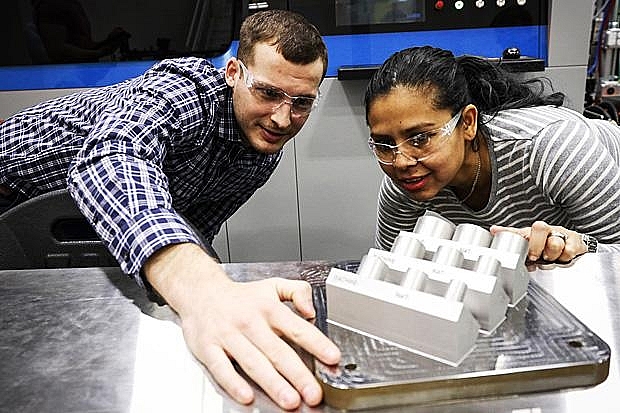 |
| Employees examine a metal component created by an M2 LaserCusing machine, part of the Concept Laser system at the GE Additive facility in Pittsburgh, Pennsylvania. GE coined the trademarked term LaserCusing from the C in Concept Laser and the word fusing. |
Most of us still think of 3D printing in terms of small units that can print simple three-dimensional solid objects from a digital computer file. But big industrial companies such as General Electric (GE) have taken this concept to extraordinary lengths and are applying it on a much larger scale to create highly complex machine parts made from metal.
3D printing is the operation at the heart of a process known as additive manufacturing (AM), which involves creating an object by building it one layer at a time. AM has been around for three decades but until recently most of the items produced were polymer-based. Recent advances that allow for the creation of sophisticated metal parts have created a new buzz in the industry.
That buzz is evident at GE's Hai Phong manufacturing site in Vietnam, where AM is one of many cutting-edge operations. It specialises in wind-turbine generators and electrical control system components and has exported some 6,000 generator units in the past decade. That makes it a key contributor to GE Renewable Energy, which has installed more than 400 gigawatts of generating capacity globally and has sales exceeding US$10 billion annually.
The Hai Phong site is one of only five GE locations worldwide to earn the designation "Brilliant Factory". It contains all the state-of-the-art innovations that you expect from a smart factory including advanced data analytics, Internet of Things and robotics applications. The only other "brilliant" GE site in Asia Pacific is its healthcare manufacturing site in Hino, Japan.
GE now operates in 15 countries in Asia Pacific with 23 manufacturing sites but only Hino and Hai Phong support all four of the company's new pillars: lean manufacturing, digital maturity, advanced manufacturing and additive manufacturing.
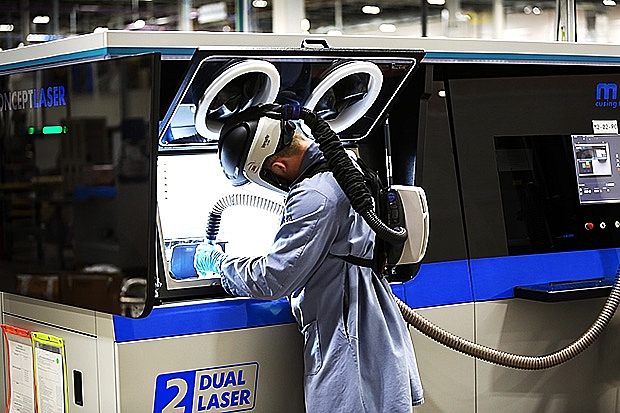 |
| The M2 Concept Laser machine in action in Pittsburgh, where GE Additive makes 3D-printed metal parts to high specifications for a number of customers. |
Other GE sites in the region will eventually undertake the same journey as Hino and Hai Phong but it won't be easy. "It is a long and challenging journey to transform and develop a Brilliant Factory," said Trang Vu, general manager of the Hai Phong facility.
"As a company, Asia Pacific is a very important region and we have a constant focus on this part of the world and we are always looking for ways to optimise our supply chain," Wouter Van Wersch, president and CEO of GE Asia Pacific, said of the possibility of making all of its facilities "brilliant".
"If the market requires it, we could grow further as this is a question of demand and supply," he said. "There is definitely a push that we have and ultimately, we want all of our factories to be brilliant.
"This requires some investment so we will do it gradually over time and we will utilise all the technology that we have in-house to make it happen."
FASTER, CHEAPER, BETTER
By optimising manufacturing processes, a smart factory can reduce product lead time by up to 50% and reduce inventory by about 20%, while increasing productivity by up to 20%. As a conglomerate with aviation, healthcare, power, renewable energy, digital industry, lighting, transport as well as oil and gas operations, GE aims to cut between $3 billion and $5 billion a year in costs across the group, a lot of it thanks to AM technology.
Lean manufacturing and digital maturity at the Hai Phong factory are apparent in almost everything you can see, from simple handheld tools that are all digitally connected to its in-house Predix system to monitor the efficiency and performance of all equipment.
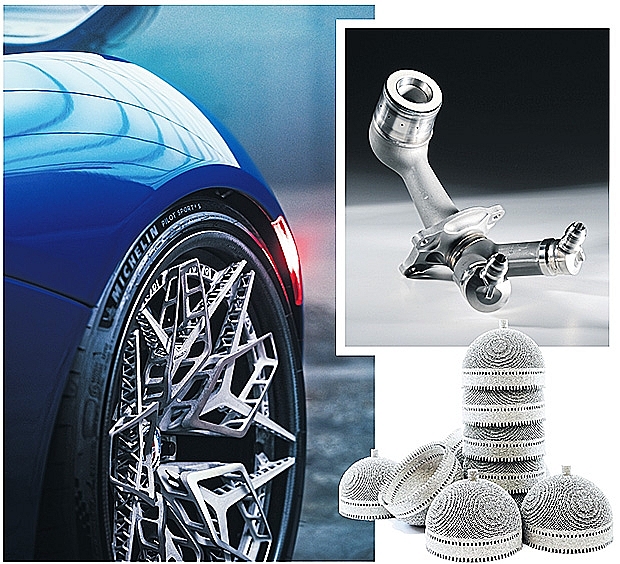 |
| Examples of GE Additive 3D-printed products: Stackable replacement hip cups made on an Arcam EBM machine; a 3D-printed jet-fuel nozzle for a LEAP aircraft engine; and the first 3D-printed titanium wheel, created for HRE Wheels using two Arcam EBM machines. |
All employees use digital ID tags to start and operate machines, while automatic delivery robots run along the yellow lines on the floors. Now the company knows exactly who is using each machine, at what time and for how long, and can use this data to evaluate the performance of machine operators. The data can also be used for predictive maintenance to keep machines from breaking down.
The use of data analytics while the machines are communicating with one another allows for all processes and workflows involved in making generators and electrical components to be constantly optimised and refined.
Behind the scenes, augmented and virtual reality are being used increasingly in the design and manufacturing processes, with technology that allows components with extremely complex internal geometry to be created from a computer.
Additive manufacturing, GE says, is all about creating "lighter, stronger parts and systems" with improved performance that would be impossible with traditional processes. The ability to print functional parts from metal alloys represents a turning point that has spurred a lot of investment in AM in recent years.
GE Additive and its partner SmarTech Publishing, an industry analysis firm, estimate that $13 billion was spent on 3D printers, materials, software and services from 2014-18, with half of that being spent in 2017 alone. They forecast that $280 billion will be invested in AM over the next decade.
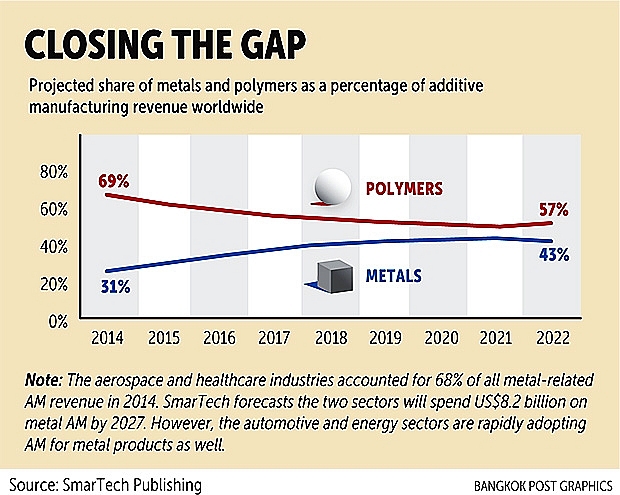 |
Wohlers Associates, which has published annual reports on AM for 23 years, said the industry worldwide grew by 21% from 2016 to 2017, reaching a market value of $7.3 billion. It estimated that 1,768 metal AM systems were sold in 2017, an increase of nearly 80% from the year before, as "global manufacturers are becoming aware of the benefits of producing metal parts by additive manufacturing".
Globally, 135 companies produced and sold industrial AM systems in 2017, up from 97 in 2016. These systems are defined as machines that sell for more than $5,000 per unit. There are now more machines available with open material platforms, faster printing speeds and lower prices than ever before.
AM uses data from computer-aided-design (CAD) software or 3D object scanners to direct hardware to deposit material, layer upon layer, in precise geometric shapes. AM adds ultrathin layers of material to create an object, while traditional processes remove material through milling, machining, carving or shaping.
JET ENGINE INNOVATION
Building an aircraft engine requires a lot of complex mechanical and electrical parts. GE Aviation, the world's largest supplier of jet engines, is constantly looking for easier, cheaper and better ways to make them. That is where AM comes in.
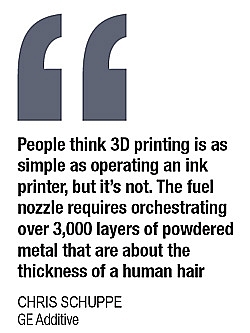 |
For example, GE Aviation now uses AM to produce a fuel nozzle for jet engines by printing the part with lasers rather than casting and welding the metal. Prior to this breakthrough, AM was used only to make only niche items such as medical implants and plastic prototypes for engineers and designers. So GE's decision to mass-produce a critical metal-alloy part of its jet engines is a "significant milestone for the technology", said Martin LaMonica, contributing editor at MIT Technology Review.
A jet fuel nozzle, shaped like a water faucet and connected to two stumpy legs, might be small enough to hold in a palm of your hand but it is now one of GE's best examples of AM technology in action. Since October, the 3D-printing facility at GE Aviation in Auburn, Alabama has produced some 30,000 units of this small but complex item.
It all started more than 10 years ago when CFM International, a 50-50 joint venture between GE Aviation and Safran Aircraft Engines of France, was developing the LEAP engine, a new commercial jet engine that promised fewer emissions. The engineers involved in the project encountered a problem with a component that held the key to burning less fuel than existing engines, which was inside the tip of the fuel nozzle where jet fuel and air are mixed together.
To support an engine that would burn less fuel and release fewer emissions, they came up with a walnut-sized object that housed 14 fluid passages to be installed in the tip of the nozzle. The problem was that the design for the interior geometry was complicated to the point that it was impossible to make.
At the time, GE Aviation was using AM only for prototypes, but the technology had advanced to the point where a nozzle tip that once consisted of 20 separate pieces welded together could now be produced as a single piece. It also weighed 25% less, was five times more durable, and 30% more cost-efficient than its predecessor, partly because the printing machines can run around the clock.
"People think 3D printing is as simple as operating an ink printer, but it's not," Chris Schuppe, the head of the GE Additive AddWorks team, said in GE Reports in November. "The fuel nozzle requires orchestrating over 3,000 layers of powdered metal that are about the thickness of a human hair."
The part is now built from a bed of cobalt-chromium powder while a computer-controlled laser shoots pinpoint beams onto the bed to melt the metal alloy in the desired areas, creating 20-micrometre-thick layers one by one.
STAYING COMPETITIVE
Mr Van Wersch says GE has experienced "no difficulty" in deploying AM technology internally where "people are used to working in a certain way but change is always something that you have to do to stay competitive".
GE Power & Water, which makes large gas and wind turbines, has also identified parts it can make with AM, and GE Healthcare has used the technology to develop a method to print transducers, the expensive ceramic probes used in ultrasound machines.
"It's really fundamentally changing the way we think about the company," Mark Little, GE's chief technology officer, told MIT Technology Review in 2013. By 2015, the company was printing the enhanced fuel nozzle in Alabama with more than 40 3D printers at its disposal. The plant delivered a total of 8,000 fuel nozzles in 2017 and some are now being used in engines that power both the Airbus A320neo and Boeing 737 Max jets. Total orders for the LEAP engine have exceeded 16,000, valued at $236 billion.
GE Aviation is also using AM to make sensors, blades, heat exchangers and other parts for engines like the GE9X, the world's largest jet engine, to the smaller Catalyst turboprop engine. It has just a dozen components compared with 855 in its predecessor.
Some of the most exciting applications for AM have emerged in the field of health care. Few people are aware that 3D-printed parts for hip replacement have already been around for more than a decade.
An Italian surgeon, Guido Grappiolo, was the first person to propose the procedure when patient who needed a hip replacement came to him in 2007. He worked with an orthopaedic implant maker and Arcam, a 3D printer maker that is now part of GE Additive, to develop the world's first 3D-printed hip cup.
The Delta-Trabecular titanium cup is still working well for the first woman who received it, while more than 100,000 other patients have been fitted with the units since then.
"We have dedicated teams in every business who are looking at how can we do more with 3D printing but we only want to do this when it makes sense," said Mr Van Wersch. "We will not do 3D printing on everything -- the assignment is business by business and product by product."
What the stars mean:
★ Poor ★ ★ Promising ★★★ Good ★★★★ Very good ★★★★★ Exceptional
 Tag:
Tag:
Related Contents
Latest News
More News
- Addressing Vietnam's energy challenges with aeroderivative gas turbines (February 28, 2023 | 09:33)
- How to sprint ahead in 2023’s worldwide energy priorities (February 08, 2023 | 13:55)
- Boosting Vietnam's grid stability through gas turbine technology (November 22, 2022 | 20:02)
- Healthcare trio collaborates to provide thousands of free breast scans (October 27, 2022 | 17:19)
- GE Healthcare's vision for AI-backed radiology (September 29, 2022 | 11:53)
- GE brand trio to shape the future of key industries (July 19, 2022 | 15:35)
- GE unveiling brand names and defining future (July 19, 2022 | 15:16)
- GE: the shortest route towards sustainability (July 18, 2022 | 08:00)
- Be proactive in an uncertain world (May 20, 2022 | 11:40)
- GE secures first 9HA combined cycle power plant order in Vietnam (May 16, 2022 | 17:06)























 Mobile Version
Mobile Version